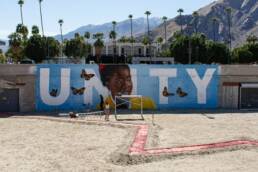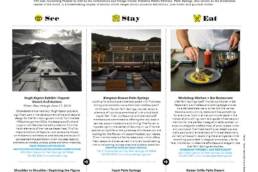Interview by: Whitney Wolff
Edited by: Isabelle Braun
An Exclusive Interview with Grit Development’s Michael Braun and Hohmann Fine Art Gallery’s Christian Hohmann
IN YOUR OPINION, WHAT IS THE VALUE OF BRINGING THIS INTERNATIONAL ARTIST/ PERSPECTIVE TO PALM SPRINGS?
MB: I wanted to bring another attraction other than Retailers and Restaurants to Downtown Palm Springs; Christian Hohmann has the knowledge about great art pieces and understood right away what I was looking for.
CH: Great art has the power to transform. It’s fascinating on so many levels and it draws people. More people visit museums than major sport events (http:// www.rangerrik.com/2017/02/museum-facts.html) and public art or sculpture has transformed many cities (for example Chicago – Anish Kapoor, Bilbao – Guggenheim Museum). Art tourism is very much a thing, and when visitors are faced with numerous travel opportunities they tend to choose the destinations that look the most interesting. And an installation by a world renown artist can tip the scale when all else is equal.
ARE THE SCULPTURES PERMANENT? IF NOT, HOW LONG WITH THEY BE THERE?
MB: Christian and David Černý committed to a minimum of 20 months; I was very grateful for their generosity
CH: Unfortunately, Černý’s sculptures are very expensive and there was no way of funding a purchase. Through the great relationship with the artist and his love for Palm Springs we were able to convince him to lend this installation at no cost for the time being. This way we can compete – even if just temporarily – with major cities that have lots of spending power. Even though everybody involved worked for free, the logistics of getting the Babies from Prague to Palm Springs were expensive and Michael Braun funded the project completely and with no help from the city or use of taxpayer’s money.
CAN YOU TELL US A QUICK BACK HISTORY ON WHERE THE SCULPTURES CAME FROM?
MB: I will leave the original reason of their creation to Christian to explain; despite their historic significance 30 years ago; I was drawn to them because of my three children and all their friends; Technology for better or worse is transforming our societies
CH: Černý first came up with the concept of the baby with the imprint of a barcode instead of a face in the early 90s for an exhibition in the Museum of Contemporary Art in Chicago. From there it was developed further and then the Babies multiplied. They were exhibited in London, the Netherlands, Germany, basically all over Europe and one installation even sold to Australia into a private collection. In 2000, the city of Prague approached Černý to come up with an idea for a major public installation to be on display during the year 2001, when Prague would be the cultural capital of Europe. The idea of placing 10 babies onto the TV Tower, a 300 feet tall building towering over the city, was met with skepticism, but was ultimately realized. After a bureaucratic battle of permits and code restrictions, Černý was able to finish the installation in time. By the time, the installation was supposed to be taken down, the people of Prague had fallen in love with the “Tower Babies” and voted to keep the installation permanently, so the company who owns the TV Towers purchased them. Most recently it was decided to rebuild the babies with new materials due to concerns of increased wind loads in the city, so Černý received the original set back. It was at that time that we had talked to Michael Braun about ideas for the empty building site and it was serendipitous that Černý had visited just weeks before and had met Braun and visited the Palm Springs Art Museum. Černý had fallen in love with Palm Springs and everything it stands for and consequently agreed to lend the installation at no cost.
WHAT DO THE BARCODES ON THE FACE REPRESENT?
MB: While the initial message was referencing Russia and the Iron curtain between East and West, I view them as an example of today’s technology driven world and impact on the next generation.
CH: Černý’s original inspiration was the barcode. Invented in 1974, it didn’t get widely used in Europe, especially Eastern Europe until the late 1980s. Černý was concerned about the tendencies to slap a number on everything, wondering if society would stop at products or would start putting barcodes on people. He also saw that people were incredibly indifferent, if not enthusiastic about the technology and he wanted to create a wake-up call. By taking the most precious thing to humankind, a baby, and placing an imprint of a barcode where the face should be, Černý didn’t just take away the individuality, he symbolized the loss of our humanity. Had he done that with an adult person sculpture, people would have barely noticed, but using the baby stirred raw emotions. Interestingly enough, 30 years after he had this original idea, the fear or threat remains as just as valid as it was then, if not more. Today, we see young adults with barcode tattoos, who it’s cool, not knowing or not remembering that just 80 years ago the Holocaust victims were marked with numbers, the equivalent to a barcode. To battle ignorance and indifference, mere words do not suffice. Černý’s strong visuals stir controversy and emotions, and that is why he creates – to make a point, a “wake up” call, so to speak.
WHY DO YOU FEEL ART IS IMPORTANT TO PALM SPRINGS?
MB: Art is part of our culture experience; it’s a snapshot of today’s world events
CH: Art is important anywhere, but especially in a city like Palm Springs, art can serve as a catalyst. Palm Springs is a city that prides itself with tolerance, acceptance and expression of freedom in almost every way. But there is also an unspoken code of political correctness. An art installation allows for a hypothetical conversation, a discourse where all opinions are allowed. Everybody can be a critic, one doesn’t have to be qualified to have an opinion, and in the resulting discussion we learn a lot about ourselves and others, because we are free to discuss without consequence or hurting anyone’s feelings.
WHAT MOTIVATES YOU TO BRING ART TO DOWNTOWN PALM SPRINGS?
MB: Art and business normally do not mix well, than I met Christian Hohmann . A lot of invested dollars later …..Isabelle and the Babies came to Downtown and I am very very happy to have listened to Christian and Ann Sheffer, Chair of the Palm Springs Public Arts Commission.
CH: I have been in the art business my entire life and giving artists an audience has always been my passion. Michael Braun’s courage, vision and generosity allowed us to take that concept to another level. The audience we were able to reach with the projects Isabelle and the Babies is beyond our wildest dreams. It makes all the hard work worth it.
WHAT CAN ADULTS LEARN FROM THE YOUNG PEOPLE OF TODAY AND VICE VERSA?
MB: Baby Boomers and Millennials complement each other – both together determine the latest consumer trends.
CH: I believe that there has always been a generational cross-pollination, but today more than ever, the young generation has the advantage of having grown up with technology to the degree where it is second nature, good or bad, while older generations face a steep learning curve. Information used to be scarce and valuable, now we have to deal with the overload of information. Again, I believe that we only learn by listening to each other, young and old, straight and gay, republican and democrats, one race to another, etc. In the end we will find that there is more that unites us than divides us, but it requires a conversation.
HOHMANN FINE ART?
MB: My wife and I were introduced to Christian at a dinner party in 2005 and we became friends. Then in 2016, the City of Palm Springs asked me to build a fountain in front of the Kimpton Hotel. I reached out to Christian to do something more extraordinary than a fountain, knowing that only something special would work. We then both worked with the Palm Springs Art Commission and the City Council to bring Isabelle and later the Černý Babies to Downtown.
CH: I met Michael and Wendy Braun years ago through a wonderful mutual friend, another German, who has since moved away. One day I received a phone call from Michael and he asked me if I could come to see the construction site. Apparently everybody was pushing for a fountain in a very prominent space, but Michael had a different vision and he wanted some out-of-the-box thinking. To be asked to be a part of his vision of reshaping downtown is such a privilege. It was hard to keep up with Michael’s pace, passion and dedication, but my team and our artists worked tirelessly to make this come together.
WHY IS CONTEMPORARY ART AT THE EPICENTRE OF THE ART MARKET TODAY?
MB: I know what I love and I love the contemporary time period. It reflects my time and it is created by my peers. I understand the value, both monetary and historically, of old masters, but it’s a time that has come and gone. I live in the now and I like art that reflects that. I believe that I am not alone in that sentiment, judging by the price development in recent years. But more importantly, contemporary artists aren’t afraid to push boundaries and be controversial. Controversy is the one thing in today’s world that always brings attention, and I wanted to bring attention to this artist, this work, and this city.
CH: The way contemporary art is received, we have a first in art history. Usually artists had to pass away before a major public breakthrough. This is the first time in art history that living artist fetch higher prices than old masters. There are many factors that are at work, but one of them is that human knowledge grows at a rapid pace (http://www.industrytap.com/knowledge-doubling-every-12-months-soon-to-be-every-12-hours/3950) . Up until 1900 human knowledge doubles every hundred years, today it is already doubling every year. The fact that we can access this knowledge quite literally with our fingertips has multiplied the desire to find the next big thing. Art is no exception. Contemporary is the art of today, of tomorrow.
ARE YOU CURRENTLY WORKING ON OTHER ART INSTALLATIONS DOWNTOWN? WHAT CAN WE LOOK FORWARD TO FROM A PUBLIC ART STANDPOINT?
MB: Christian inspired me as a Developer to look at Art; it is up to him to convince me again to work with him to fund one of his next ideas. Let me put it this way, he understands where I am coming from and knows how to convince me to do the right thing for this great destination
CH: The wonderful thing is that there are many public art projects underway, not just what we did. The next edition of Desert X is coming and more and more people are getting on board with the idea that Palm Springs has the potential to be an art destination in addition to everything else that draws people already. We will continue to work hard to come up with great ideas and we look forward to many more projects with Michael Braun and Grit Development. It was a great effort to finalize these two recent projects in such a short time so close together, but the new season is around the corner and Michael is not known to sit still for long.


